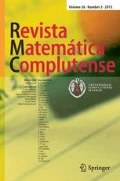Abstract
Using the operator valued Fourier transform, the \(C^{*}\)-algebras of connected real two-step nilpotent Lie groups are characterized as algebras of operator fields defined over their spectra. In particular, it is shown by explicit computations, that the Fourier transform of such \(C^{*}\)-algebras fulfills the norm controlled dual limit property.
Similar content being viewed by others
References
Brown, I.: Dual topology of a nilpotent Lie group. Ann. Sci. l’É.N.S. 4e Sér. Tome 6(3), 407–411 (1973)
Corwin, L., Greenleaf, F.P.: Representations of nilpotent Lie groups and their applications. Part I. Basic theory and examples. In: Cambridge Studies in Advanced Mathematics, vol. 18. Cambridge University Press, Cambridge (1990)
Dixmier, J.: \(C^{*}\)-algebras. Translated from French by Francis Jellett. In: North-Holland Mathematical Library, vol. 15. North-Holland, Amsterdam (1977)
Lahiani, R.: Analyse Harmonique sur certains groupes de Lie à croissance polynomiale. Ph.D. thesis, University of Luxembourg and Université Paul Verlaine-Metz (2010)
Leptin, H., Ludwig, J.: Unitary representation theory of exponential Lie groups. In: De Gruyter Expositions in Mathematics, vol. 18. Berlin (1994)
Lin, Y.-F., Ludwig, J.: The \(C^{*}\)-algebras of \(ax+b\)-like groups. J. Funct. Anal. 259, 104–130 (2010)
Ludwig, J., Turowska, L.: The \(C^{*}\)-algebras of the Heisenberg Group and of thread-like Lie groups. Math. Z. 268(3–4), 897–930 (2011)
Ludwig, J., Zahir, H.: On the nilpotent \(*\)-Fourier transform. Lett. Math. Phys. 30, 23–24 (1994)
Pukanszky, L.: Leçons sur les représentations des groupes. Dunod, Paris (1967)
Regeiba, H.: Les \(C^{*}\). Ph.D. thesis, Université de Lorraine (2014)
Regeiba, H., Ludwig, J.: \(C^{*}\)-Algebras with Norm Controlled Dual Limits and Nilpotent Lie Groups (2013). arXiv:1309.6941
Acknowledgments
This work is supported by the Fonds National de la Recherche, Luxembourg (Project Code 3964572).
Author information
Authors and Affiliations
Corresponding author
Appendix
Appendix
Lemma 1
Let V be a finite-dimensional euclidean vector space and S an invertible, skew-symmetric endomorphism. Then V can be decomposed into an orthogonal direct sum of two-dimensional S-invariant subspaces.
Proof
S extends to a complex endomorphism \( S_{\mathbb {C}}\) on the complexification \(V_{\mathbb {C}}\) of V, which has purely imaginary eigenvalues.
If \( i\lambda \in i{\mathbb {R}}\) is an eigenvalue, then also \( -i\lambda \) is a spectral element. Denote by \( E_{i\lambda } \) the corresponding eigenspace. These eigenspaces are orthogonal to each other with respect to the Hilbert space structure of \( V_{\mathbb {C}}\) coming from the euclidean scalar product \( \langle \cdot ,\cdot \rangle \) on V.
Let for \( i\lambda \) in the spectrum of \( S_{\mathbb {C}}\)
If \( \lambda \ne 0 \), \( dim (V^{\lambda } ) \) is even and \(V^{\lambda } \) is S -invariant and orthogonal to \(V^{\lambda '} \), whenever \( |\lambda |\ne |\lambda '| \):
Indeed, one then has for \( x\in V^{\lambda }, x'\in V^{\lambda '}\) that
Therefore,
Thus, one has
Suppose that \(dim (V^{\lambda } )>2\), choose a vector \( x\in V^{\lambda } \) of length 1 and let \(y=S(x)\). Since \(S_{\mathbb {C}}^2=-\lambda ^2 \text {Id}\), both on \(E_{i\lambda }\) and on \(E_{-i\lambda }\),
This shows that \( W_1^{\lambda }:= \text {span} \{x,y\} \) is an S-invariant subspace of \( V^{\lambda } \). If \( V_1^{\lambda } \) denotes the orthogonal complement of \( W_1^{\lambda } \) in \( V^{\lambda } \), then \(V_1^{\lambda } \) is S -invariant, since \(S^t=-S\).
In this way one can find a decomposition of \( V^{\lambda } \) into an orthogonal direct sum of two-dimensional S -invariant subspaces \(W_j^{\lambda } \) and by summing up over the eigenvalues, one obtains the required decomposition of V.
Rights and permissions
About this article
Cite this article
Günther, JK., Ludwig, J. The \(C^{*}\)-algebras of connected real two-step nilpotent Lie groups. Rev Mat Complut 29, 13–57 (2016). https://doi.org/10.1007/s13163-015-0177-7
Received:
Accepted:
Published:
Issue Date:
DOI: https://doi.org/10.1007/s13163-015-0177-7



